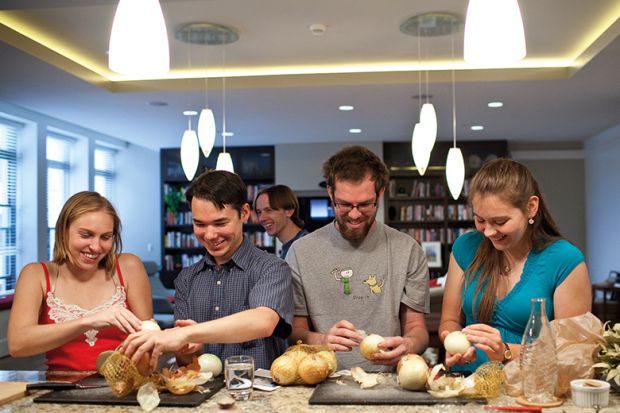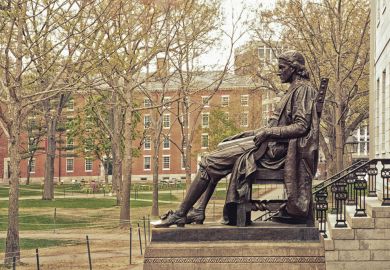Like many US colleges, Virginia Tech struggles with costs. Almost half its graduates leave with loan debt averaging more than $30,000 (£22,700) apiece.
But unlike many US colleges, its students don’t seem to be getting especially grumpy about it.
The atmosphere, senior Rachel Iwicki explained, is filled with “kind of this infectious love for the school that really catches on with a lot of people”. Zo Amani, a graduate student serving alongside Ms Iwicki as a representative to the university’s governing body, put it even more simply: “It feels like home.”
In an era of mounting student loan debt and dire predictions about vast numbers of US colleges expected to fail in coming years, Virginia Tech is among a few campuses that might be worth scrutinising for solutions.
The reason is reflected in the new Wall Street Journal/Times Higher Education College Rankings, which reveal a troubling trend. On the upside, data compiled for the 2019 rankings show US colleges registering across-the-board increases in various measures of overall quality of education and teaching.
But on a key measure of student satisfaction – a survey question asking recent graduates if they would recommend their college to a friend or family member – the 2019 numbers show across-the-board declines for virtually all major categories of US colleges, public and private.
See the top 20 recommended US universities from the Wall Street Journal/Times Higher Education College Rankings
In what serves as a clue to that negative sentiment, “financial aid” was the element that students in the survey selected most often as an area in which their institution should improve. A separate report earlier this year by Hart Research Associates found that 65 per cent of US college students are greatly concerned about college costs and loan debt – a record high for the survey, up from 56 per cent last year. More than a third of the students in the survey said that they had skipped meals because they could not afford it.
Virginia Tech has at least some of those cost-related woes. Its $30,000 average for the 49 per cent of its students leaving with debt is not unambiguously better than the nationwide situation, which is 65 per cent of graduates having debt, at an average of $28,650 apiece.
But Virginia Tech students, somehow, seem almost uniformly happy about their choice. In the survey question asking graduates if they’d recommend the experience to a friend or family member, Virginia Tech had an average recommendation score of 9.3 out of 10 – putting it in the top three in the entire nation on that score.
The second-place institution, scoring 9.4, is Stanford University, already well-established as one of the world’s most admired institutions. The nation’s first-place campus – James Madison University, another public research institution in Virginia – also received a 9.4 score.
On a financial level, JMU’s student satisfaction rate may be somewhat easier to understand than Virginia Tech’s. JMU’s graduate debt levels run near or below national averages, and its loan default level of 2.2 per cent sits well below the national average of 7.3 per cent.
Both JMU and Virginia Tech nevertheless describe at least some common approaches, largely based on making students happy and engaged by keeping them focused on ways of helping others.
It’s the type of slogan likely heard on many campuses. At Virginia Tech, however, the concept is implemented by a range of practices not common elsewhere, or at least not common to the same extent. Along with a list of student bonding events during the year, the more unique practices include having large numbers of faculty teach and even live in student dormitories, and arranging near-universal student participation in extensive class-related training activities such as running the campus’ cafeteria, hospitality operations and fitness centre.
The cumulative result is a remarkably high level of shared community concern, Ms Iwicki said.
JMU has some different approaches to community-building, although many also add up to the goal of getting students to feel good about their situation by thinking about the well-being of others, said its president Jonathan R. Alger.
A prime example, he added, is the campus’ Student Success Centre. It’s similar to the student centres found on many US college campuses, with food and casual gathering points. But a main component is space for various types of academic work, including areas to meet faculty or trained student tutors, Dr Alger said. The facility, which has drawn interest from many other universities, is set up to make ongoing learning a “no stigma attached” campus norm, he added.
JMU also emphasises widespread undergraduate research experiences in which students are tasked with solving real-world problems – often brought by outside businesses or government agencies – and using ethical reasoning approaches that are built into a variety of programmes and courses on campus, Dr Alger continued. “It gets students thinking beyond themselves – about the impact of choices and decisions on the world,” he said.
后记
Print headline: Happy graduates: the key ingredients




